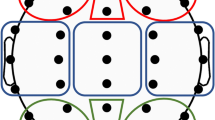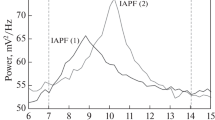Abstract
During a course of electroconvulsive therapy (ECT), the level of currency necessary to induce an epileptic seizure in a patient may either remain relatively stable or—more often—may require repeated upward adjustment over time due to a constantly increasing seizure threshold. We aimed to determine whether a common polymorphism of the brain-derived neurotrophic factor (BDNF), which constitutes an important and ubiquitously expressed neurotrophine in the brain, affects the stimulation threshold of ECTs required to induce an epileptic seizure over time. Twenty-seven adult patients who underwent at least 12 consecutive ECT sessions were analyzed for the stimulation intensities required during the course of the stimulation as well as their BDNF gene status. We could not find a relation between the Val/Met polymorphism of the BDNF and the development of the seizure threshold during the course of the ECT sessions. Mechanisms and predispositions other than the BDNF polymorphism investigated in this study are responsible for the change in seizure thresholds over the course of ECT.


Similar content being viewed by others
References
Folkerts H, Remschmidt H, Saß H, Sauer H, Schäfer M, Sewing KF (2003) Stellungnahme zur Elektrokrampftherapie (EKT) als psychiatrische Behandlungsmaßnahme. Dt Ärzteblatt 100:504–506
Bratfos O, Haug JO (1965) Electroconvulsive therapy and antidepressant drugs in manic-depressive disease. Treatment results at discharge and 3 months later. Acta Psychiatr Scand 41(4):588–596
Brandon S, Cowley P, McDonald C, Neville P, Palmer R, Wellstood-Eason S (1985) Leicester ECT trial: results in schizophrenia. Br J Psychiatry 146:177–183
Gregory S, Shawcross CR, Gill D (1985) The Nottingham ECT study. A double-blind comparison of bilateral, unilateral and simulated ECT in depressive illness. Br J Psychiatry 146:520–524
Ulett GA, Smith K, Gleser GC (1956) Evaluation of convulsive and subconvulsive shock therapies utilizing a control group. Am J Psychiatry 112(10):795–802
Kirstein L, Ottosson JO (1960) Experimental studies of electroencephalographic changes following electroconvulsive therapy: the role of the electrical stimulation and of the seizure studied by variation of stimulus intensity and modification by lidocaine of seizure discharge. Acta Psychiatr Scand Suppl 35(145):49–67
Boylan LS, Haskett RF, Mulsant BH, Greenberg RM, Prudic J, Spicknall K, Lisanby SH, Sackeim HA (2000) Determinants of seizure threshold in ECT: benzodiazepine use, anesthetic dosage, and other factors. J ECT 16:3–18
van Waarde JA, van Oudheusden LJ, Verwey B, Giltay EJ, van der Mast RC (2013) Clinical predictors of seizure threshold in electroconvulsive therapy: a prospective study. Eur Arch Psychiatry Clin Neurosci 263(2):167–175
Sackeim HA, Decina P, Portnoy S, Neeley P, Malitz S (1987) Studies of dosage, seizure threshold, and seizure duration in ECT. Biol Psychiatry 22:249–268
Chanpattana W, Buppanharun W, Raksakietisak S et al (2000) Seizure threshold rise during electroconvulsive therapy in schizophrenic patients. Psychiatry Res 96:31–40
Malitz S, Sackeim HA, Decina P, Kanzler M, Kerr B (1986) The efficacy of electroconvulsive therapy. Ann NY Acad Sci 462:56–64
Scott AIF, Boddy H (2000) The effect of repeated bilateral electroconvulsive therapy on seizure threshold. J ECT 16:244–251
Shapira B, Lidsky D, Gorfine M, Lerer B (1996) Electroconvulsive therapy and resistant depression: clinical implications of seizure threshold. J Clin Psychiatry 57:32–38
Coffey CE, Lucke J, Weiner RD, Krystal AD, Aque M (1995) Seizure threshold in electroconvulsive therapy (ECT) II. The anticonvulsant effect of ECT. Biol Psychiatry 37:777–788
Sackeim HA (1999) The anticonvulsant hypothesis of the mechanisms of action of ECT: current status. J ECT 15:5–26
Post RM, Putnam F, Uhde TW, Weiss SR (1986) Electroconvulsive therapy as an anticonvulsant. Implications for its mechanism of action in affective illness. Ann NY Acad Sci 462:376–388
Ernfors P, Bengzon J, Kokaia Z, Persson H, Lindvall O (1991) Increased levels of messenger RNAs for neurotrophic factors in the brain during kindling epileptogenesis. Neuron 7:165–176
Poo M-M (2001) Neurotrophins as synaptic modulators. Nat Rev Neurosci 2:24–32
Shimizu E, Hashimoto K, Masaomi I (2004) Ethnic difference of the BDNF 196G/A (val66met) polymorphism frequencies: the possibility to explain ethnic mental traits. Am J Med Gen Part B 126B:122–123
Egan MF, Kojima M, Callicott JH, Goldberg TE, Kolachana BS, Bertolino A, Zaitsev E, Gold B, Goldman D, Dean M, Lu B, Weinberger DR (2003) The BDNF vall66met polymorphism affects activity-dependent secretion of BDNF and human memory and hippocampal function. Cell 112:257–269
Bueller JA, Aftab M, Sen S, Gomez-Hassan D, Burmeister M, Zubieta J-K (2006) BDNF Val55Met allele is associated with reduced hippocampal volume in healthy subjects. Biol Psychiatry 59:812–815
Gruber O, Hasan A, Scherk H, Wobrock T, Schneider-Axmann T, Ekawardhani S, Schmitt A, Backens M, Reith W, Meyer J, Falkai P (2012) Association of the brain-derived neurotrophic factor val66met polymorphism with magnetic resonance spectroscopic markers in the human hippocampus: in vivo evidence for effects on the glutamate system. Eur Arch Psychiatry Clin Neurosci 262(1):23–31
Chen Z-Y, Jing D, Bath K, Ieraci A, Khan T, Siao C-J, Herrera DG, Toth M, Yang C, McEwen BS, Hempstead BL, Lee FS (2006) Genetic variant BDNF (Vall66Met) polymorphism alters anxiety-related behavior. Science 314:140–143
Siironen J, Juvela S, Kanarek K, Vilkki J, Hernesniemi J, Lappalainen J (2007) The Met allele of the BDNF Val66Met polymorphism predicts poor outcome among survivors of aneurysmal subarachnoidal hemorrhage. Stroke 38:2858–2860
Krueger F, Pardini M, Huey AD, Raymont V, Solomon J, Lipsky RH, Hodgkinson CA, Goldman D, Grafman J (2011) The role of the MEt66 brain-derived neurotrophic factor allele in the recovery of executive functioning after combat-related traumatic brain injury. J Neurosci 31:598–606
Musil R, Zill P, Seemüller F, Bondy B, Obermeier M, Spellmann I, Bender W, Adli M, Heuser I, Zeiler J, Gaebel W, Maier W, Rietschel M, Rujescu D, Schennach R, Möller HJ, Riedel M (2013) No influence of brain-derived neurotrophic factor (BDNF) polymorphisms on treatment response in a naturalistic sample of patients with major depression. Eur Arch Psychiatry Clin Neurosci 263(5):405–412
Gall CM, Isackson PJ (1989) Limbic seizures increase neuronal production of messenger RNA for nerve growth factor. Science 245:758–761
Antal A, Chaieb L, Moliadze V, Monte-Silva K, Poreisz C, Thirugnanasambandam N, Nitsche MA, Shoukier M, Ludwig H, Paulus W (2010) Brain-dervived neurotrophic factor (BDNF) gene polymorphisms shape cortical plasticity in humans. Brain Stimul 3:230–237
Cheeran B, Talelli P, Mori F, Koch G, Suppa A, Edwards M, Houlden H, Bhatia K, Greenwood R, Rothwell JC (2008) A common polymorphism in the brain-derived neurotrophic factor gene (BDNF) modulates human cortical plasticity and the response to rTMS. J Physiol 586:5717–5725
Sha’ari HM, Haerian BS, Baum L, Tan HJ, Rafia MH, Kwan P, Cherny SS, Sham PC, Gui H, Raymond AA, Lim KS, Mohamed Z (2015) Association of BDNF polymorphisms with the risk of epilepsy: a multicenter study. Mol Neurobiol 53:2869–2877
Bocchio-Chiavetto L, Zanardini R, Bortolomasi M, Abate M, Segala M, Giacopuzzi M, Riva MA, Marchina E, Pasqualetti P, Perez J, Gennarelli M (2006) Electroconvulsive Therapy (ECT) increases serum brain derived neurotrophic factor (BDNF) in drug resistant depressed patients. Eur Neuropsychopharmacol 16(8):620–624
Bumb JM, Aksay SS, Janke C, Kranaster L, Geisel O, Gass P, Hellweg R, Sartorius A (2015) Focus on ECT seizure quality: serum BDNF as a peripheral biomarker in depressed patients. Eur Arch Psychiatry Clin Neurosci 265(3):227–232
Okamoto T, Yoshimura R, Ikenouchi-Sugita A, Hori H, Umene-Nakano W, Inoue Y, Ueda N, Nakamura J (2008) Efficacy of electroconvulsive therapy is associated with changing blood levels of homovanillic acid and brain-derived neurotrophic factor (BDNF) in refractory depressed patients: a pilot study. Prog Neuropsychopharmacol Biol Psychiatry 32(5):1185–1190
McCall WV, Shelp FE, Weiner RD, Austin S, Norris J (1993) Convulsive threshold differences in right unilateral and bilateral ECT. Biol Psychiatry 34:606–611
Mukherjee S (1989) Mechanisms of the antimanic effect of electroconvulsive therapy. Convuls Ther 5:227–243
Sackeim HA, Decina P, Prohovnik I, Malitz S, Resor SR (1983) Anticonvulsant and antidepressant properties of electroconvulsive therapy: a proposed mechanism of action. Biol Psychiatry 18(11):1301–1310
van Waarde JA, van Oudheusden LJ, Tonino BA, van der Wee NJ, Verwey B, van der Mast RC, Giltay EJ (2013) MRI characteristics predicting seizure threshold in patients undergoing electroconvulsive therapy: a prospective study. Brain Stimul 6(4):607–614
Acknowledgements
We would like to thank Prof. P. Falkai and Dr. Alkomiet Hassan for reading the study protocol for the ethical committee. We thank Frank Rohrborn and Henrik Fleige for their assistance in accessing patients’ charts.
Author information
Authors and Affiliations
Corresponding author
Ethics declarations
Conflict of interest
On behalf of all authors, the corresponding author states that there is no conflict of interest.
Rights and permissions
About this article
Cite this article
Stephani, C., Shoukier, M., Ahmed, R. et al. Polymorphism of the brain-derived neurotrophic factor and dynamics of the seizure threshold of electroconvulsive therapy. Eur Arch Psychiatry Clin Neurosci 267, 787–794 (2017). https://doi.org/10.1007/s00406-016-0744-z
Received:
Accepted:
Published:
Issue Date:
DOI: https://doi.org/10.1007/s00406-016-0744-z




